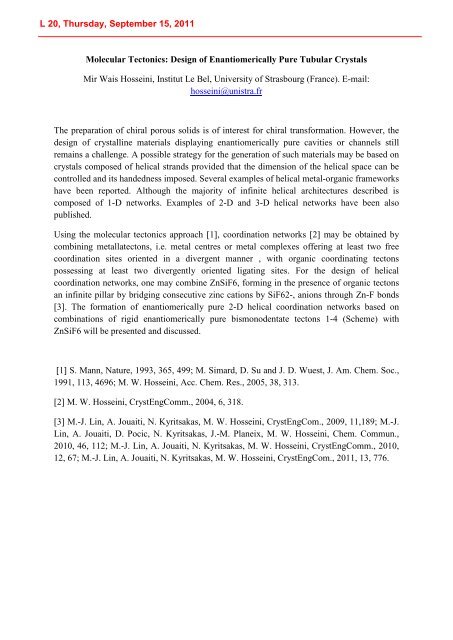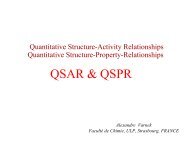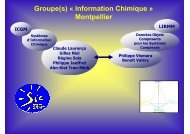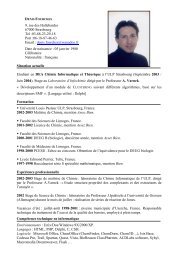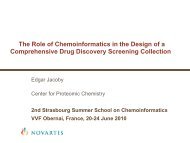International Summer School PROGRAM - Laboratoire d'Infochimie ...
International Summer School PROGRAM - Laboratoire d'Infochimie ...
International Summer School PROGRAM - Laboratoire d'Infochimie ...
You also want an ePaper? Increase the reach of your titles
YUMPU automatically turns print PDFs into web optimized ePapers that Google loves.
Molecular Tectonics: Design of Enantiomerically Pure Tubular Crystals<br />
Mir Wais Hosseini, Institut Le Bel, University of Strasbourg (France). E-mail:<br />
hosseini@unistra.fr<br />
The preparation of chiral porous solids is of interest for chiral transformation. However, the<br />
design of crystalline materials displaying enantiomerically pure cavities or channels still<br />
remains a challenge. A possible strategy for the generation of such materials may be based on<br />
crystals composed of helical strands provided that the dimension of the helical space can be<br />
controlled and its handedness imposed. Several examples of helical metal-organic frameworks<br />
have been reported. Although the majority of infinite helical architectures described is<br />
composed of 1-D networks. Examples of 2-D and 3-D helical networks have been also<br />
published.<br />
Using the molecular tectonics approach [1], coordination networks [2] may be obtained by<br />
combining metallatectons, i.e. metal centres or metal complexes offering at least two free<br />
coordination sites oriented in a divergent manner , with organic coordinating tectons<br />
possessing at least two divergently oriented ligating sites. For the design of helical<br />
coordination networks, one may combine ZnSiF6, forming in the presence of organic tectons<br />
an infinite pillar by bridging consecutive zinc cations by SiF62-, anions through Zn-F bonds<br />
[3]. The formation of enantiomerically pure 2-D helical coordination networks based on<br />
combinations of rigid enantiomerically pure bismonodentate tectons 1-4 (Scheme) with<br />
ZnSiF6 will be presented and discussed.<br />
[1] S. Mann, Nature, 1993, 365, 499; M. Simard, D. Su and J. D. Wuest, J. Am. Chem. Soc.,<br />
1991, 113, 4696; M. W. Hosseini, Acc. Chem. Res., 2005, 38, 313.<br />
[2] M. W. Hosseini, CrystEngComm., 2004, 6, 318.<br />
[3] M.-J. Lin, A. Jouaiti, N. Kyritsakas, M. W. Hosseini, CrystEngCom., 2009, 11,189; M.-J.<br />
Lin, A. Jouaiti, D. Pocic, N. Kyritsakas, J.-M. Planeix, M. W. Hosseini, Chem. Commun.,<br />
2010, 46, 112; M.-J. Lin, A. Jouaiti, N. Kyritsakas, M. W. Hosseini, CrystEngComm., 2010,<br />
12, 67; M.-J. Lin, A. Jouaiti, N. Kyritsakas, M. W. Hosseini, CrystEngCom., 2011, 13, 776.


